 |
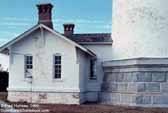 |
Flash
Back 30 years:
This 1973 photo (left) shows the lighthouse base in obvious
disrepair. The 2003 photo at right shows there has been some
effort to maintain the exterior. The park service does not allow
climbing by the public because they say it needs renovation
to make it safe. In fact, it has never been open for the public
to climb. |
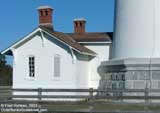 |
| 1973 |
2003 |
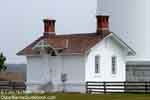 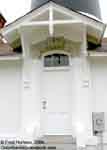
Entry
to Bodie Island Lighthouse is through the work building attached
to the base, shown at left. Identical in design and layout to
Currituck Beach Lighthouse, it too has a dated granite arch
over the outside door. Note in the photo at right the victorian
style decorations, vertical and horizontal "sticks",
so popular in Outer Banks construction. The photo below at left
shows the eave support detail of the work room building.
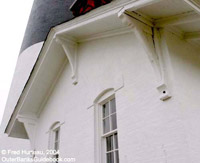 The
left photo shows details of the eaves. The two photos at right
show the north work room and the south work room. Note the curved
blocks on the black "bench" of the south work room,
present at either end of that room. This is where drums of oil
were stored for use in the old oil lantern used as the lighthouse
beacon, before the beacon was electrified. The floor is marble
tiled in black and white, as is the hallway and the bottom floor
at the base of the stairs around the "well".
The
left photo shows details of the eaves. The two photos at right
show the north work room and the south work room. Note the curved
blocks on the black "bench" of the south work room,
present at either end of that room. This is where drums of oil
were stored for use in the old oil lantern used as the lighthouse
beacon, before the beacon was electrified. The floor is marble
tiled in black and white, as is the hallway and the bottom floor
at the base of the stairs around the "well". |
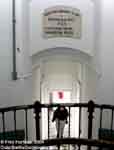 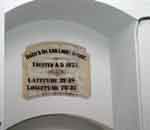 At
left is the view from the inside looking out. You are at the
center of the lighthouse base by the "well", looking
down along the central hallway out the front door. The work
rooms are on either side of the hall. The hallway ceiling is
high and arched.
At
left is the view from the inside looking out. You are at the
center of the lighthouse base by the "well", looking
down along the central hallway out the front door. The work
rooms are on either side of the hall. The hallway ceiling is
high and arched.
Above where the hallway opens into the
lighthouse base is a granite
plaque. The photo below right shows the close-up detail
of the plaque, which gives the location of the lighthouse
in latitude and longitude, and the date. Don't
let the dates throw you. The plaque inside says 1872, when the
construction was completed. The date on the arch outside over
the front door says 1871, which was when construction began.
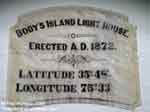
You might note the spelling on the plaque
says "Body's Island Light House" instead of Bodie Island Lighthouse.
The spelling of the name varied from one map to another and
one document to another, which was a very common occurrence
in those days. Many names on the Outer Banks were spelled different
ways until things became more standardized in the early to mid
20th century. |
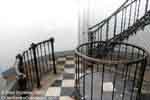 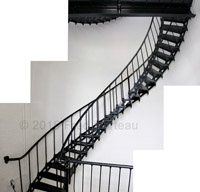 The
left photo here (pre-restoration image) shows the base of the
lighthouse stairs, and the "well", fenced in by the circular
railing, and covered by the round black plate. This is where
the weights used to power the beacon's geared rotating mechanism
would be lowered for servicing. The weights hung from the top,
down the center of the circular stairs. It was wound up by the
keeper to keep the rotating gears working, much like a grandfather
clock runs. The right photo is a 3-image composite of the first
flight of stairs (post-restoration image).
The
left photo here (pre-restoration image) shows the base of the
lighthouse stairs, and the "well", fenced in by the circular
railing, and covered by the round black plate. This is where
the weights used to power the beacon's geared rotating mechanism
would be lowered for servicing. The weights hung from the top,
down the center of the circular stairs. It was wound up by the
keeper to keep the rotating gears working, much like a grandfather
clock runs. The right photo is a 3-image composite of the first
flight of stairs (post-restoration image).
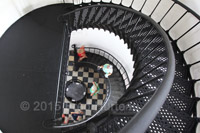 The left image shows the first landing with the "well" and base floor below it. At right are two views looking up the
center of the stairs. This view is identical to Currituck Beach
Lighthouse. All the landings are on the same side of the structure
(except the last one at the very top), so you can see all the
way up in the half-round opening. Both Bodie Island and Currituck
Beach Lighthouses take a good photo up the stairs. Cape Hatteras
Lighthouse, on the other hand, is a problem, since every landing
alternates to the opposite side, leaving only a narrow slit
to photograph beyond the next flight up.
The left image shows the first landing with the "well" and base floor below it. At right are two views looking up the
center of the stairs. This view is identical to Currituck Beach
Lighthouse. All the landings are on the same side of the structure
(except the last one at the very top), so you can see all the
way up in the half-round opening. Both Bodie Island and Currituck
Beach Lighthouses take a good photo up the stairs. Cape Hatteras
Lighthouse, on the other hand, is a problem, since every landing
alternates to the opposite side, leaving only a narrow slit
to photograph beyond the next flight up. |
Here
are a few additional photos of Bodie Island Lighthouse
taken at various times of the day. With the open expanse
of sky all around, it's a great place to shoot a sunrise
or sunset. Even days with great billowy clouds provide
a wonderful backdrop against which to photograph this
lighthouse.
|
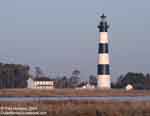
An
early morning photo
looking west from
highway
NC
12. |
|
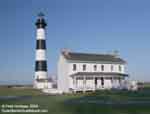
This photo was taken in late afternoon, looking eastward. |
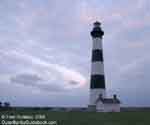
A
sunset masked by dark clouds in the west instead gave
light and color to the eastern sky, providing an interesting
backdrop for this photo.
|

This
is one of the photos taken just before sunset, discussed
in the Travel Journal entry above. |
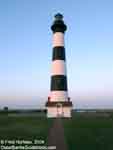
The
soft orange glow of the western sky after sunset lights
this scene facing east. |
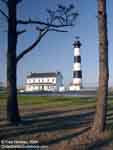
The
long shadows of a late afternoon are evident in this shot
framed by pines. |
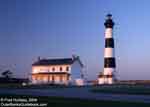
The
brilliant red glow of the setting sun lights this scene,
and reflects off the windows of the Keeper's Quarters.
|
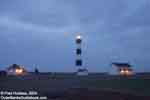 Just
like it's twin, Currituck Beach Lighthouse, the beautiful
1st Order Fresnel lens at Bodie Island provides a wonderful
warm glow that photographs much better at night than the
narrowly focused airport beacons used at Cape Hatteras
and Cape Lookout Lighthouses. This gives night photos
much more character and interest, as seen at right, on
an evening with a foggy mist settling in. Just
like it's twin, Currituck Beach Lighthouse, the beautiful
1st Order Fresnel lens at Bodie Island provides a wonderful
warm glow that photographs much better at night than the
narrowly focused airport beacons used at Cape Hatteras
and Cape Lookout Lighthouses. This gives night photos
much more character and interest, as seen at right, on
an evening with a foggy mist settling in. |
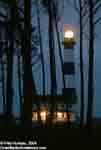
The
beacon illuminates a light foggy mist around the lantern. |
|
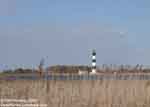 |
With
every change in the sunlight and sky, Bodie Island Lighthouse
takes on a different mood, making it an endlessly fascinating
location for photos. |
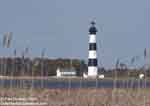 |
|
|
|


